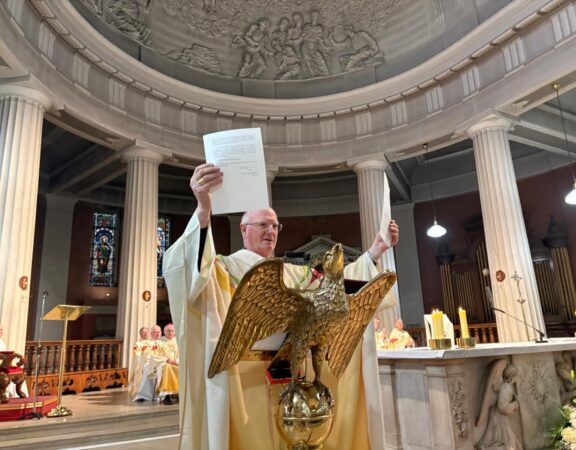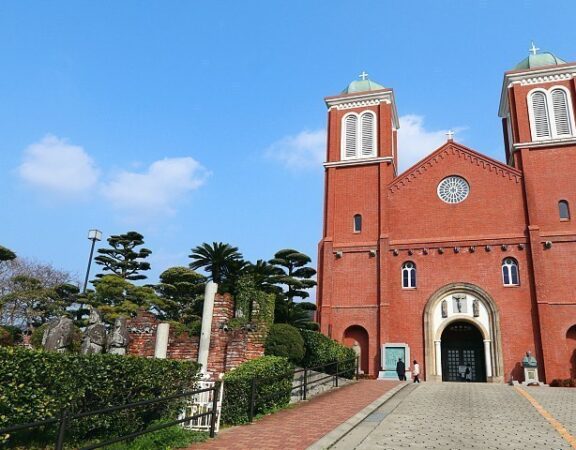FEAST OF THE BAPTISM OF THE LORD 2013 Homily Notes of Archbishop Diarmuid Martin Pro-Cathedral, 13th January 2013
“At Christmas we celebrated the birth of Jesus. The Gospel narrative of Jesus’ birth is not just a cold historical narrative. There Gospel contains a deeper message. We learn something vital about the identity of Jesus through the way he was manifested and shown through the circumstances of his birth. In the grotto of Bethlehem, Jesus was cared for by Mary and Joseph and then first manifested to poor shepherds in the humility of the manger. The key to understanding the identity of this new-born was first indicated not to the powerful and influential but to the poor.
At the Feast of the Epiphany the manifestation of Jesus becomes wider; he is manifested to the Magi who represent not power or an exclusive group, but rather all the peoples of the earth. Jesus comes to bring salvation to all. Today, on the Feast of the Baptism of the Lord, the manifestation of Jesus and his identity to the people of Israel begins, as Jesus makes his first appearance in public as an adult.
Jesus begins his public ministry. He enters the public scene for the first time after leaving Nazareth. In all humility, almost in anonymity, he joins the multitudes that had gone out into the desert to encounter John the Baptist and to be baptised by him.
Saint John the Baptist was the first real prophet to arise in Israel for centuries and Saint Luke in today’s Gospel stresses how his appearance generated an extraordinary atmosphere of expectation. John’s uncompromising preaching out in the wilderness – away from the centres of power and the dominant culture – created a sense that something significant and completely new was about to take place in history. People began to ask what they should do. They turned to John in huge numbers to repent their sins. Jesus then appears among those people of Israel who had begun to live in renewed expectation.
Jesus appears alone and almost anonymously in the line of sinners who turn to John for a Baptism of repentance and conversion from sin. Even the publicans, the sinners, go out into the desert to confess their sinfulness and Jesus mingles within that crowd no different in appearance from them. The one who is without sin makes his first appearance in his public ministry almost disguised in a line of sinners and humbly accepts the baptism of John.
As soon as he sees Jesus approaching, John realizes that there is something unique in this man. He realises that Jesus is the mysterious one to whom John’s whole life is oriented and for whom he had been called to prepare the people. The expectation had now been fulfilled and John may move away fro centre-stage.
At his birth, the God of power and might revealed himself in Jesus in the extraordinary simplicity and humility of a manger. Now the Son of God, the one who is without sin, introduces himself and his mission from within a line of sinners. Jesus takes upon his shoulders the burden of the sins of all; he begins his mission by putting himself in our place, and so demonstrates God’s closeness to us in our weakness and sinfulness.
As Jesus emerges from the water after his Baptism, the skies break open. Jesus stands there in prayer and: “The heaven was opened, and the Holy Spirit descended upon him” and extraordinary words are heard: “You are my beloved Son; with you I am well pleased”. For an instant the Father, the Son and the Holy Spirit are present together openly in our world and reveal to us their love that saves. Just as the Angels brought to the shepherds the announcement of the Saviour’s birth, and the star guided the Magi to Bethlehem, now it is the Father himself who indicates the presence of his Son in the world to save us.
That revelation of the Father comes to Jesus as he stands amidst sinners. It takes place as Jesus is in communion with his Father in prayer. It takes place at the moment in which he rises from the water, giving a sign of the resurrection of Christ and of Christ’s victory over sin and death.
The identity of Jesus as the one who will free humankind from sin comes as Jesus stands surrounded by sinners. His identity, his name might well be called “mercy for sinners”. As his life and mission unfold, Jesus spends so much of his time with sinners. Those who do not like him refuse to recognise him because he eats with sinners, he claims the power to forgive sins, and even at the final moment he is crucified between two criminal sinners.
We are Christians baptised now in the spirit and have become followers of Jesus and members of his Church. In our baptism we have been made become like Christ in our inner selves, but how much have we become like Jesus in our outward life? In this moment of the Baptism of Jesus we learn that the God revealed in Jesus Christ is a God of mercy, not a distant isolated God but a God who reaches out to sinners.
We have to ask if we really believe ourselves in the power of Jesus to lead us to conversion and if we truly understand that power of Jesus. Jesus does not act primarily through threats of punishment, but by the appearance alongside sinners of a merciful love which goes way beyond our expectations and breaks out from all the schemata of the ways we think in our world.
There can be no way in which the message of Jesus can be truly preached if this dimension of his reality – his merciful love – is obscured, as indeed been often the case in history. Repeatedly in history a great and strange distortion of the Christian message has so often taken place and preaching a Jesus who is merciful way beyond our power of thought was replaced by preaching a Gospel of punishment and harshness,
In the current debates about abortion, the Church is called to preach the truth of its message, but always within its message of God’s love and care for all. We have to ask how many women in the past, for example, may have been driven to despair through the judgementalism which they encountered in the Christian community. The community of believers must rather be the place where those who suffer and are troubled are never rejected but are encountered with love and mercy and support.
The challenging teaching of Jesus will only be understood if it is presented within the framework of his love and within the context of a community which appears as a caring and loving community. New Evangelization is not about an ideology, it is about they way we encounter Jesus and allow him to change us and make us like him, rejecting the outward clinging to power and popularity and the fashions of the day, as John the Baptist did in the wilderness to prepare the way for the coming of Jesus who would reveal himself as the God of humility and mercy.
Jesus began his public life by being lovingly present alongside sinners. In his life he was called a friend of sinners. He was crucified between sinners and his final mission to his disciples was to announce to all people the remission of sin. The message of Jesus can free us from sin and free us to be the free men and women that God wishes each of us to be, free not to be entrapped in selfishness, but free to bring that same love to all.”







